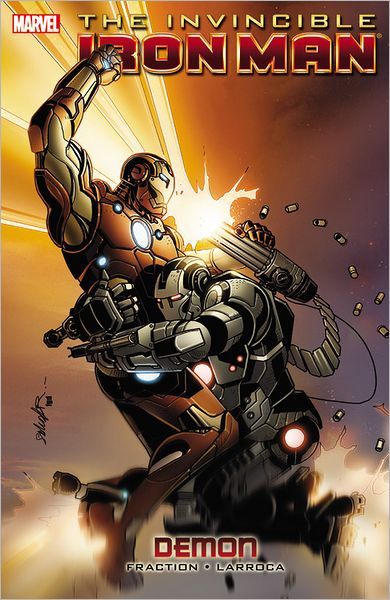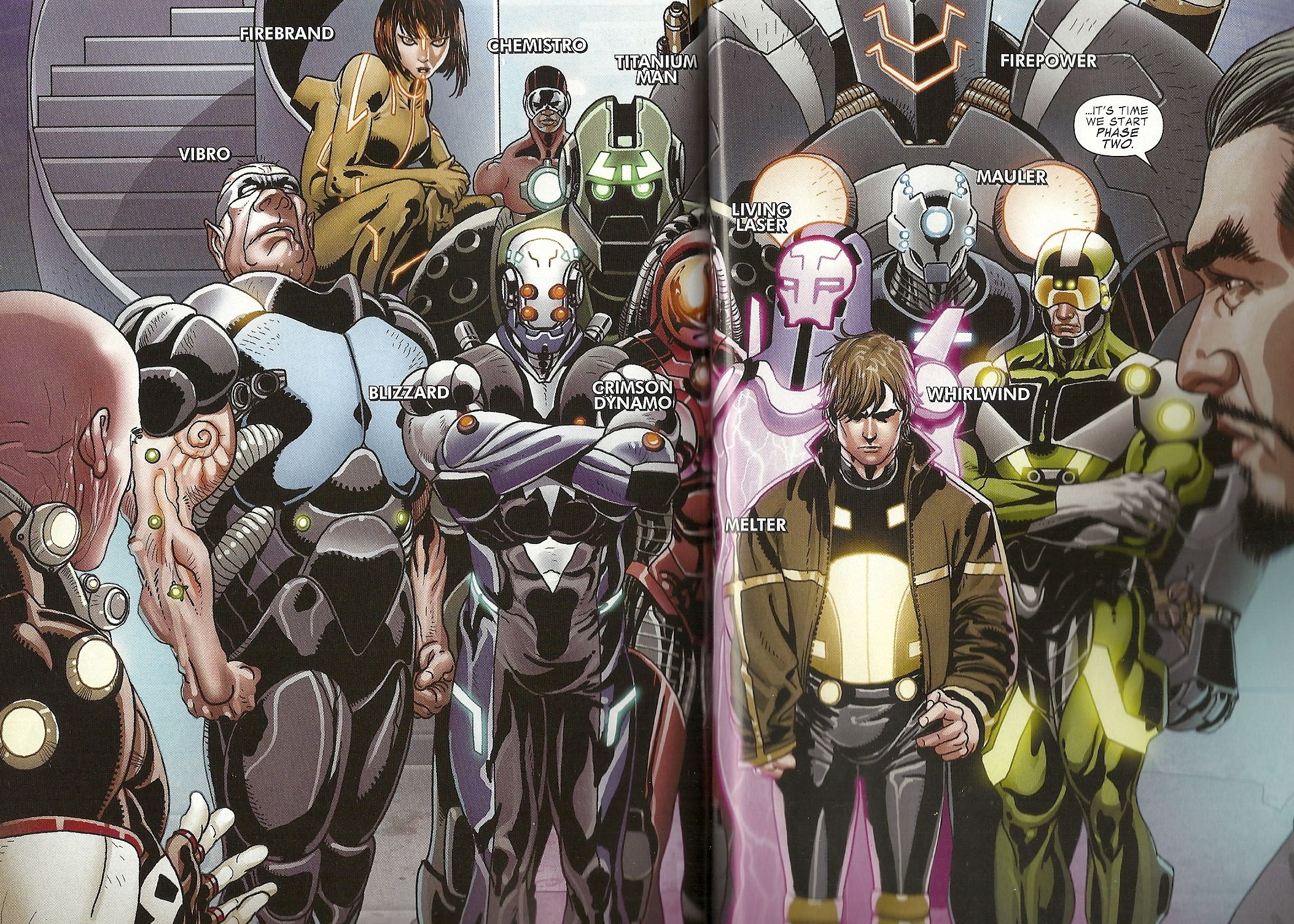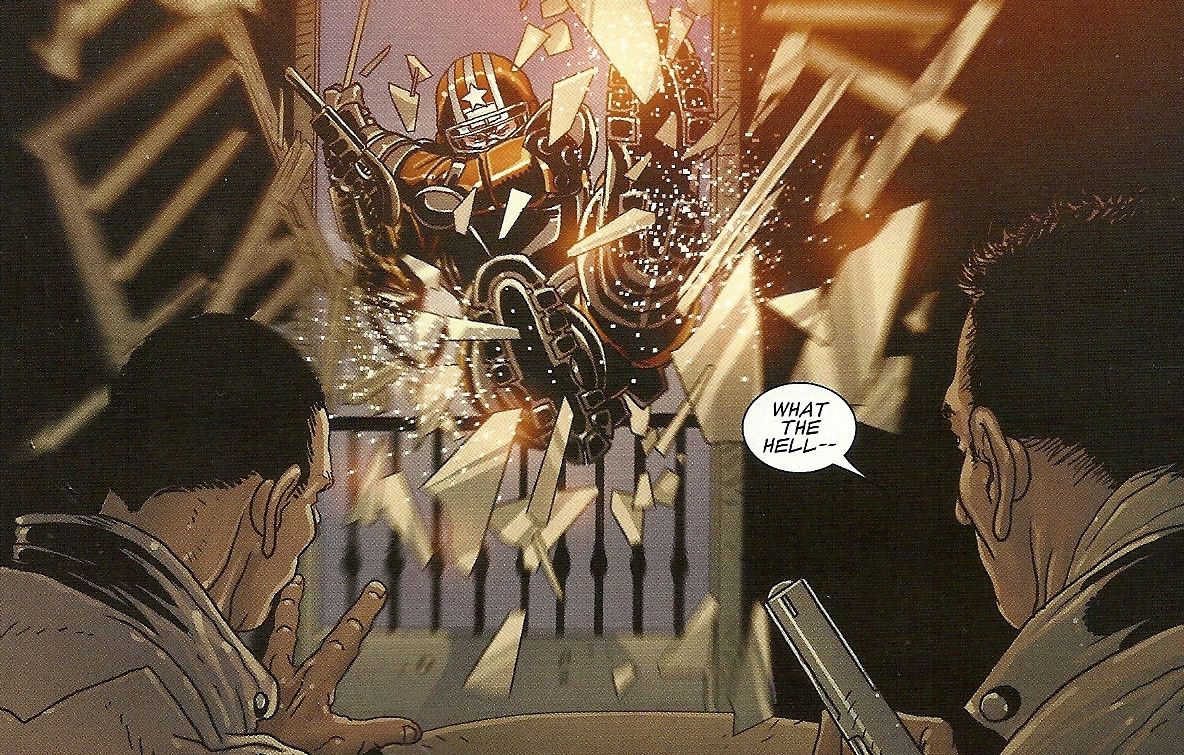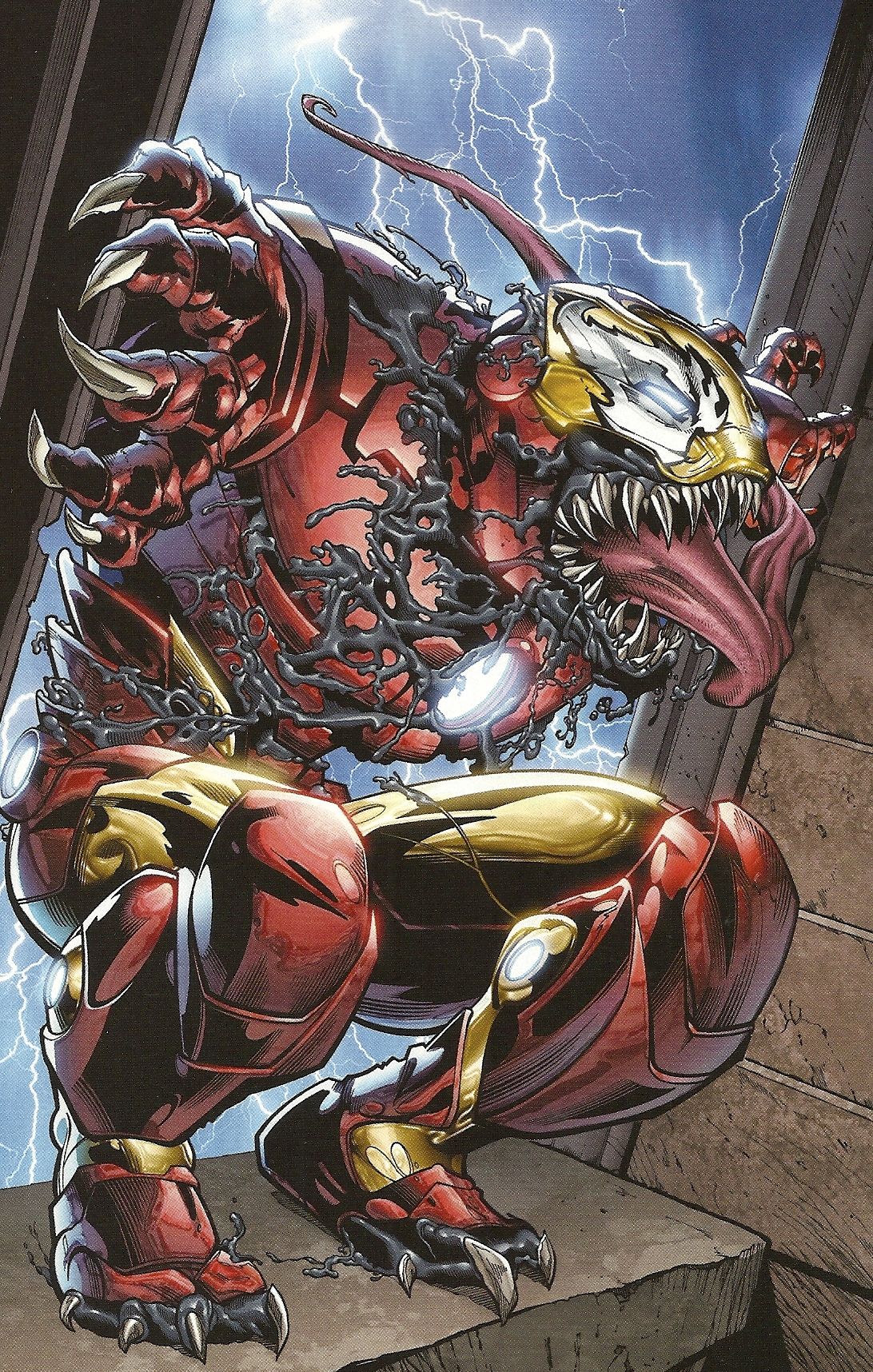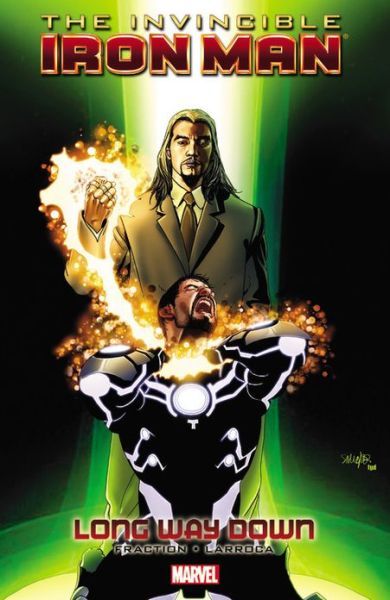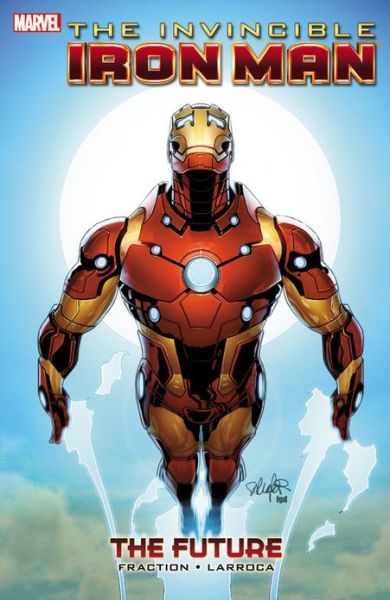This is it! The (thrilling?) conclusion of our re-reading The Invincible Iron Man series, which has covered the entire Matt Fraction and Salvador Larroca series over the course of — let's see ... one, two, three, four — five posts. Today, we look at the last year and a half worth of issues, which are collected in a trio of trades that see our hero facing off against his ultimate villain in an attempt to save the world from destruction. (Spoiler warning: He succeeds.)
Vol. 9: Demon (#510-515): Several of the long-simmering plotlines of the series had begun cooling over the course of the past few trades, in which Fear Itself, a crossover with the Spider-Man status quo and various one-shots and specials crowded out the action, but here Fraction puts them all back on the front burner and sets them to boil. The Hammer Girls and their Detroit Steel program of privatized independent-contractor mechas, the Spymaster-led espionage within Tony's tech firm Stark Resilient, Ezekiel Stane's alliance with the Mandarin — they've all come to the fore again.
Stark and his pals might have just saved the world from destruction in Fear Itself, but he hasn't come out of it in a stronger position at all. He got drunk again, which Justine Hammer uses as an excuse to have her Pentagon ally install a sort of breathalyzer-like off switch in Stark, preventing him from becoming Iron Man if they suspect he might be drunk again.
Meanwhile, The Mandarin and Stane have been upgrading various minor Iron Man rogues — mainly the super-powered thug types and those with suit-based powers — installing little bombs in them to keep them loyal, and giving them all slick redesigns in the process. We first meet a new Blizzard and then a new Living Laser, before a double-page splash reveals a veritable army.
At this point in the series, it's become abundantly clear Fraction and Larroca were doing a greatest-hits take on Iron Man's villains, not unlike what Jeph Loeb and Jim Lee did in their Batman arc "Hush," only instead of cramming all the bad guys into a few issues, they've managed to use most of them pretty organically throughout the course of several years. Here's where they seem to be getting in everyone they didn't have room for earlier.
I'm sort of ambivalent about the redesigns, which all look more movie-friendly, and thus less superhero-y and less comic book-y, but they have the benefit of looking like they belong to the same world now.
At the book's climax, The Mandarin and Stane maneuver War Machine into a battle with Whirlwind, The Living Laser and The Melter that seems to claim his life and put Stark at perhaps his lowest point since the book began. But Stark and Rhodes have a plan! "They won that game," Stark tells his just-faked-his-own-death friend, "Now they're playing ours ..."
This volume also has the dwarven smithy Splitlip joining Stark on Midgard, where the latter hopes to help the former combat his own alcoholism, introduces a Chinese super-team and what, for a few brief seconds,, I thought was an all-new, all-different NFL Superpro ...
... but actually just turned out to be the original Detroit Steel pilot, now wearing a homemade costume and rather completely insane, looking to get his suit back from Sasha and Justine Hammer.
The variant gallery at the back of this volume includes this horrifying little gem by Larry Stroman and Dave Meikis, a "Venom Variant," which is a themed variant scheme I don't even remember occurring:
Maybe I just blocked it out of my memory so as to keep that image out of nightmares? Yeesh. I'd have thought a Venom-ized Iron Man would have the sentient suit atop the Iron Man suit, not vice versa.
Vol. 10: Long Way Down (#516-520): In the penultimate volume, everything seems to come to a head: Tony quits Stark Resilient, quits the Avengers and, with help from the super-science of Reed Richards, quits being Iron Man, having the suit "vented" from his body.
A new Iron Man wearing a new suit with new powers appears, and his identity is played as something of a mystery, despite it being obvious throughout who is actually wearing the suit.
Detroit Steel attacks the Hammers and gets his suit back ... temporarily.
Spymaster finally makes his move, and the mole in Resilient is revealed. I think it's safe to say the resolution of that particular storyline was unexpected.
Stane has attempted to build the giant squid robot-things — the "Titanomechs" — from Stark's coma dreams way back in Stark: Disassembled, but a disappointed Mandarin uses his rings and bare hands to beat the living hell out of Stane for failing. Stane attempts to betray The Mandarin, only to find that one of the archvillain's rings has taken over his mind.
And, in the climax, when Stark calls The Mandarin to let him know he's quitting in order to get the villain off his back once and for all, The Mandarin reveals he's also in Stark's head, and exerting a level of control over his mind ... and has been for a long time.
Is this the end of our hero?!
No, there's another volume to go.
Vol. 11: The Future (#521-527): Fraction's run on this title is pretty amazing for a lot of reasons, which I ticked off in the first post in this series, but the one most evident in this volume is how thoroughly planned, and how long-term, that plotting was throughout the series. The last line of the book echoes the first line of the first issue, and this climax brings to fruition a conflict that was years in the making. As a pure construction job, it's something to admire.
So now The Mandarin has rendered Ezekiel Stane severely brain-damaged, and the former ingenious supervillain and Stark 2.0 is serving as Tony Stark's tool-fetcher, while the captive Stark builds the Titanomechs for The Mandarin. In an echo of Stark's origin story (in the comics and the movie) so deliberate that it's thunderous, Stark is now being held captive and forced to use his genius to build weapons for his captor. On the sly, he's secretly constructing the means of his own escape.
So while Rescue and the new Iron Man continue to fight The Mandarin's souped-up rogues gallery and face some pretty unexpected threats in the outside world, Stark and Stane are in a prison camp in Mandarin City, building Titanomechs, which, we learn throughout the course of the story, aren't simply machines, but new mechanical bodies for the Mandarin's rings -- which aren't really rings at all, but alien lifeforms trapped in ring-like objects. They are in The Mandarin's mind as he is in Stark's, and his master plan is to put them in their giant robot bodies, have them destroy Earth and, using the resulting energy unleashed, travel back to their homeworld.
To stop them and stop The Mandarin, Stark must not only build himself another Iron Man, he has to build alliances with some of his foes, including Ezekiel Stane.
I presume it's not spoiling things too much to say it all works out for the best, and Stark succeeds, in part because he's been able to turn so many enemies into allies, and because allies like the super-teams from China and The Philippines introduced in Demon and Five Nightmares, respectively, pitch in — as do the folks at Resilient. (It's too bad Thor wasn't in here as well, given the amount of time devoted to the Stark/Thor relationship; the Norse super-god being used by Fraction as a sort of stand-in for the entire Marvel Universe superhero community.)
And that, more or less, is that, with the book ending with Stark deciding to take a vacation -- which, for him, means heading out to explore space in an Iron Man suit.
This being super-comics, however, the Iron Man story doesn't really end there (just as it didn't begin with The Invincible Iron Man #1), and the month after the Fraction/Larroca run ended, Iron Man #1 by Kieron Gillen and Greg Land debuted as part of the Marvel's Marvel Now!-branded line-wide relaunch.
But it was written in such a way that it could have ended there, if Marvel wanted it to. Or if a reader wanted it to.
All in all, The Invincible Iron Man made for a complete story, and while it could have probably been even more complete — Fraction and Larroca could have ended the book with Stark's death, I suppose — it was probably as complete as a modern, in-continuity super-comic can get and, in that respect, as well as in its scale, length consistency and relative quality, it's currently the superhero comic book run to beat.
Here's hoping it gets beat, as that means we'll get at least one more mainstream superhero comic book that's this good for this long.


